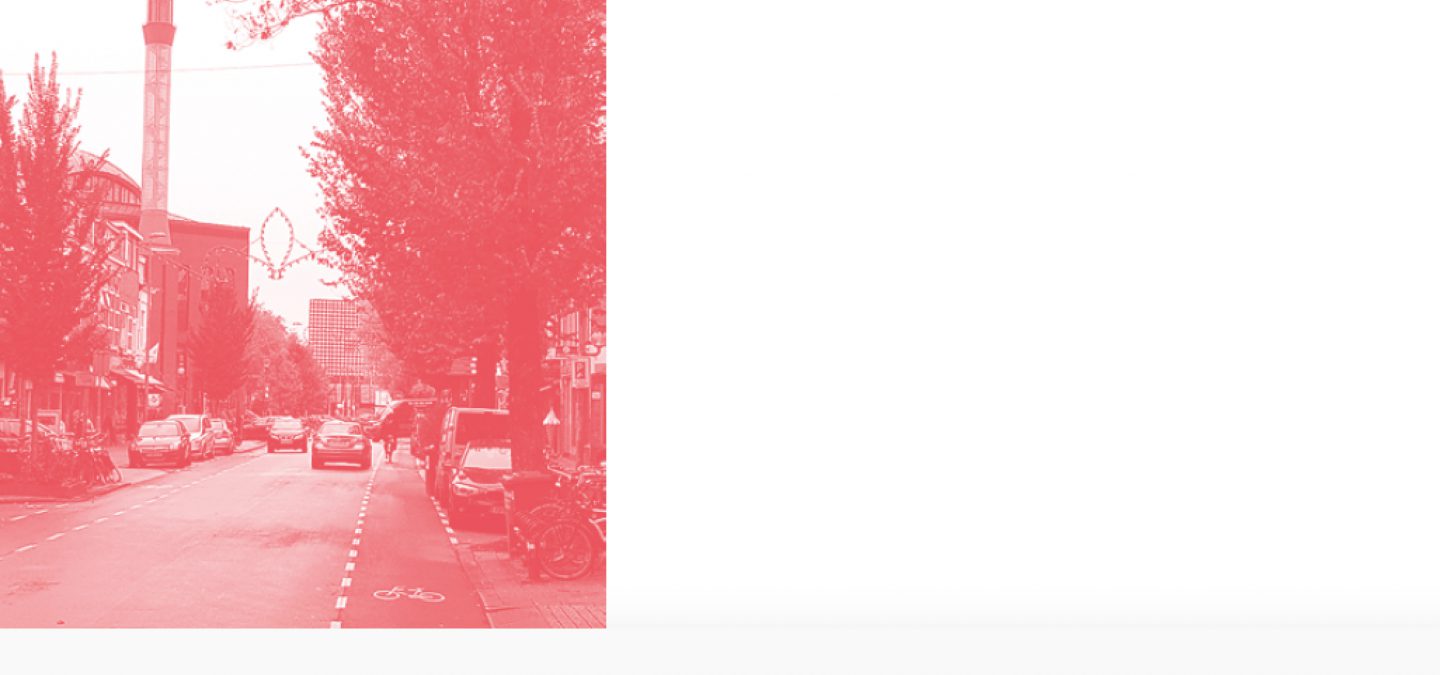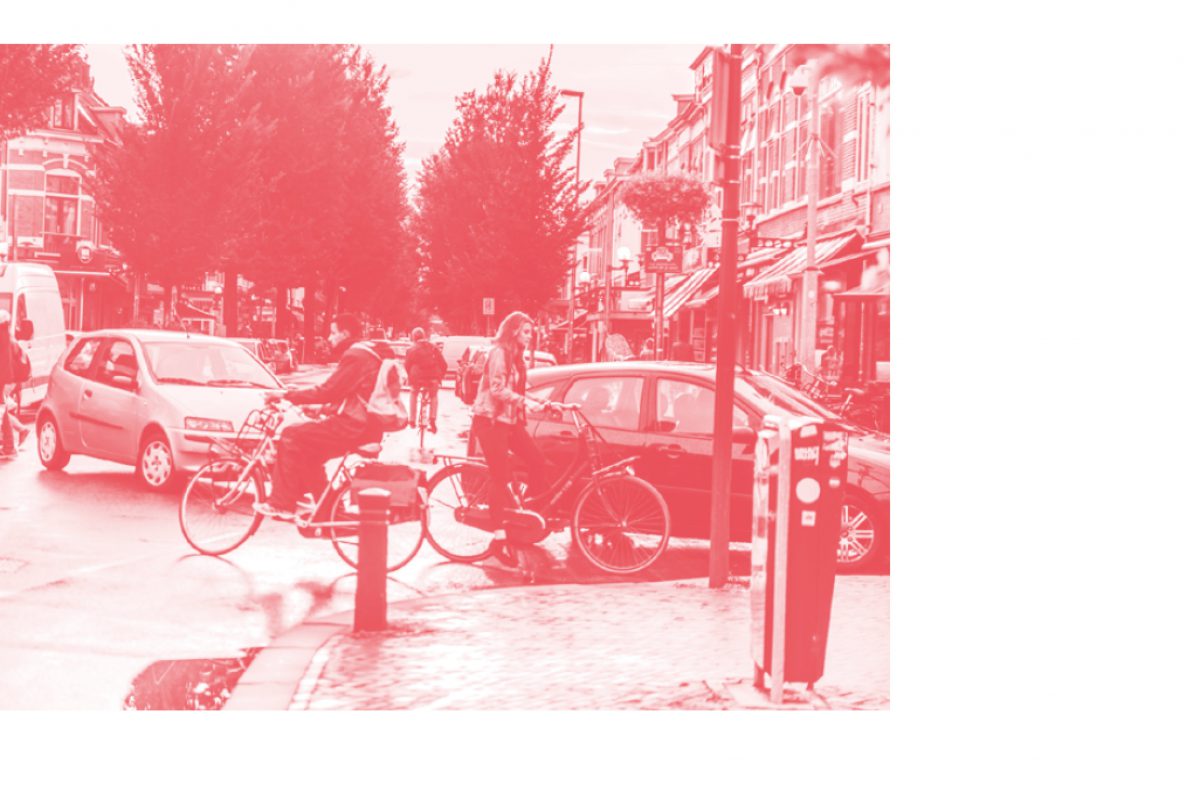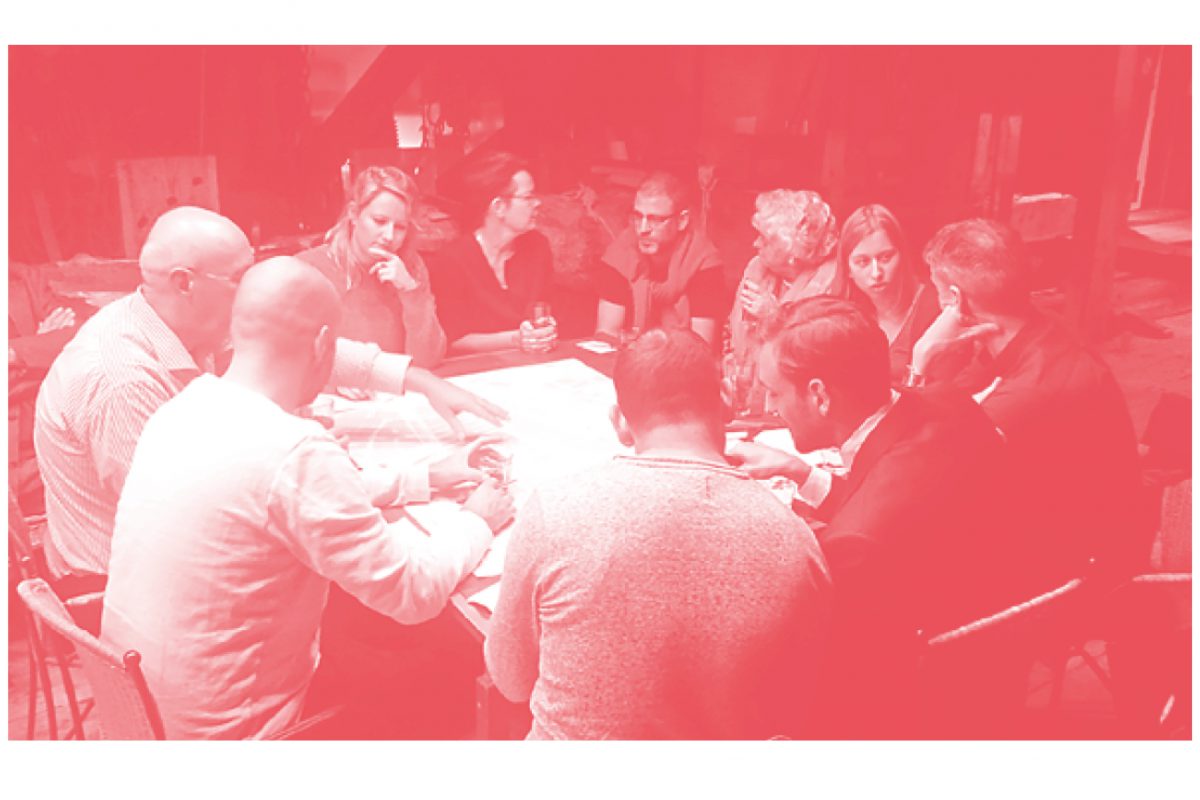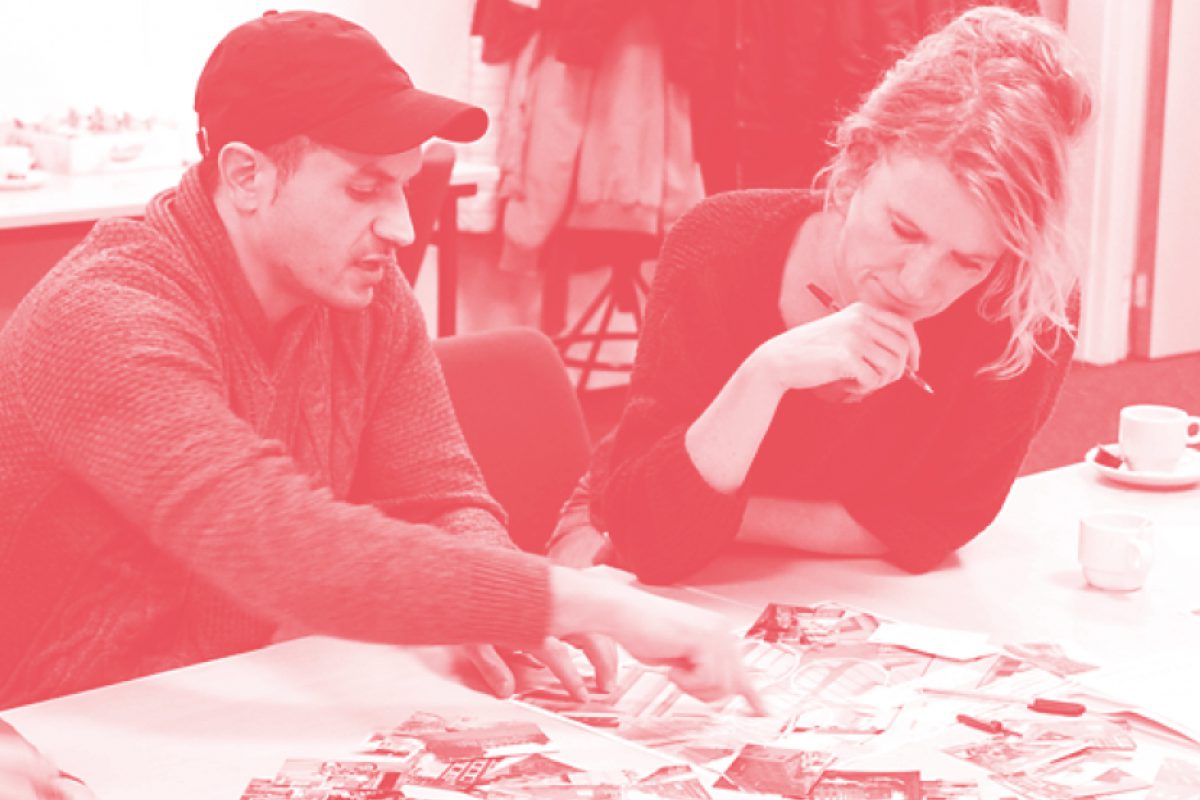
Keep up with our latest news and projects!

Police on horses dispersed a crowd of demonstrators on the square in front of the Ulu mosque at Kanaalstraat in Utrecht on October 4, 2018. The Dutch Pegida, a far-right anti-Islam movement originating from Germany, staged a demonstration in front of the mosque. Anti-demonstrators started to shout slogans and throw eggs, tomatoes and fireworks at the small group of Pegida followers. Tensions escalated and the police stopped the demonstration (RTV Utrecht, 2018). Why did Pegida choose this location?
Different users of public space with different lifestyles have different ideas about how public space should look like or how one should behave in the public domain. This may lead to severe conflicts and stand-offs in the planning and design of public space. In this chapter we explore mechanisms to overcome these conflicting situations using the case of Kanaalstraat (Utrecht, the Netherlands) as an example.
Kanaalstraat is a relatively small street, just over 700 meters long and about 18 meters wide, in a neighbourhood with 7 550 inhabitants (Werkgroep Visie Kanaalstraat/Damstraat, 2017, p. 15). At first sight, Kanaalstraat is a street like any other in the Netherlands or elsewhere in Europe. However, over the last 40 years it has acquired national fame and become a symbol of the changes taking place in Dutch society.
Neighbourhoods continuously change over time and change implies frictions. New groups of people flock in with different perspectives on the design, use and behaviour expected in public space (Cilliers & Timmermans, 2014). But does this imply that one group ‘owns’ the public space, imposes its requirements and pushes out others? Can the two meet without continuous disputes?
The Lombok neighbourhood close to the inner city of Utrecht has two faces. On the one hand, it is seen as a success story. People from all kinds of social and ethnic background live and meet together in its main street, Kanaalstraat. In the media it is often cited as a good example of a multicultural society. On the other hand, the neighbourhood is full of friction and conflict between different users of public space. Political groups from left to right use the neighbourhood to narrate their views on the state of Dutch society.1


Conflicts sometimes become grim. Different social groups hardly communicate with each other. Users of Kanaalstraat have very strong feelings about the area; it is part of their identity. They see others as ‘enemies’ who take away their definition and meaning of what the place should look like and what behaviour fits. Drug dealers muck about and cause nuisance and a feeling of social insecurity. In 2016 people from all over the city signed a massive petition to the city government demanding security for bikers in Kanaalstraat. Both shopkeepers and shop customers, typically from migrant background, tend to come by car putting pressure on the limited space for cars, bikers and pedestrians.2 In Lombok customers feel a bit like ‘home’.3 Youngsters, often born and raised in the Netherlands from parents who migrated to the country, cling together in public space and like to show off their cars and motorbikes without caring too much about traffic rules. Speed driving goes on until late at night when other people tend to sleep.4 In Kanaalstraat they feel like they can be themselves without discrimination.
Lombok was known as a working class neighbourhood and a safe-haven for migrants in the 80s and 90s. Now a process of gentrification is taking place.5 Although the neighbourhood has a multicultural, especially North African and Turkish appearance, only 23% of the inhabitants have a non-western background, similar to the city average (Werkgroep Visie Kanaalstraat/Damstraat, 2017, p. 15). The types of shops in Kanaalstraat and their customers determine the international, non-western sphere and appearance of the neighbourhood. Yet, these shops are no longer congruent with the wishes of the current residents who call for new types of business concepts such as hip coffee shops and terraces, and another use of the public space.

The municipality has been trying to reduce tensions and improve the situation through ad hoc measures for years. However, many users consider the local government part of the problem. In their view, it is doing too little, too late. Some were calling for more enforcement of laws and regulations, others – on the contrary – for more flexibility and understanding of the local situation. Project managers of the local government failed to come out of the standoff between interest groups. In 2016 the responsible alderman wanted to find a break-through and initiated a project for the development of a more consistent vision on Kanaalstraat.
The municipality appointed me as an independent process manager to get an inclusive dialogue going on the future of Kanaalstraat. After one year representatives of the neighbourhood presented a new vision to the municipality, which was broadly supported by the local community. The city council accepted the vision and agreed to reserve € 6 million for the re-design of the public space.
The main success factor responsible for getting to a shared vision was the design and implementation of an inclusive planning process. Some critical principles and elements of the process are discussed below.
Government versus governance
Citizens often react negatively to decisions taken by governments out of a feeling that they are not included in the decision-making process (see for example Oostveen, 2018). In public policy-making there is a call for a change from top-down ‘government’ to inclusive ‘governance’ (Jordan, Wurzel & Zito, 2005). ‘Governance’ is seen as a process in which policy decisions are prepared in consultation and in cooperation with networks of stakeholders and partnerships. It is not easy to act in line with this concept. It questions the primacy of governments in decision-making. It may also create social unrest and frustration among citizens if their proposals are not accepted. Yet, in conflicting situations like the one in Kanaalstraat, a process designed along this principle is the only way out.
Management of process versus management of contents
One mechanism for ensuring that interest groups are part of the planning process is to create a joint management platform. In the case of Vision Kanaalstraat a ‘process group’ was formed with residents, shopkeepers and city administration representatives. Government was seen as just one of multiple stakeholders. The process group ensured transparency and flexibility in the process. Its task was not discussing the contents of the vision, but outlining, facilitating and safeguarding the quality of the dialogue. The dialogue itself took place in the neighbourhood in which all individuals and groups could equally participate. The process group, however, indicated that not all stakeholders were sufficiently involved. Therefore, additional activities were organized such as sessions for women of migrant background. On the request of the process group, a debate was organized on the consequences and possible instruments to control gentrification. At the end of the project the process group issued a letter for the city government on the quality of the process, thus ensuring that the government would be more accepting of the outcome.

Positions versus interests
An important concept when looking for common ground is the distinction between the position of a stakeholder and his or her interests (Mutual Gains Approach see Susskind & Cruikshank, 1987; Wesselink, 2010). A ‘position’ is a stance you take on a certain issue, an ‘interest’ is a core need or want that underlies that position. Usually there are more ways to meet a particular interest than the position one stakeholder might be defending. Sharing and respecting interests is a more productive way of reaching agreement, even unexpected shared interests may be found.
In Kanaalstraat groups of residents and shopkeepers were opposing each other vehemently over the space given to cars. Shopkeepers contended that they need two-way car traffic to accommodate their customers. Residents wanted less cars and more space for pedestrians. In a dialogue session the participants analysed positions and interests. They concluded that most interests were common, but that disagreement existed on the ways to satisfy those interests. The real interest of shopkeepers was accessibility for their customers and not two-way car traffic. Common ground was found in rearranging the accessibility and parking spots for cars and in creating more quality space for pedestrians.

Role of city government and councillors
In traditional project design the city government defines a project, citizens are invited to participate with some degree of influence, and the council takes a decision.6 In a process organized along the lines of ‘governance and inclusiveness’ it is not so much a question of ‘citizen’ participation, but rather of ‘government’ participation (Van den Broek, Steenbekkers, Van Houwelingen & Putters, 2016). City councillors were invited during the process of vision development on Kanaalstraat. This was a new role for them. As a result of their involvement they felt committed to the outcome. In fact, councillors even wanted to push for a decision and take initiative before the city government had a chance to make its own judgement on the vision.
Role of professionals within the city administration
Professionals within a city administration, such as urban planners and traffic experts, are key in the realisation of a vision on public space. In the Vision Kanaalstraat a group of experts from the city administration was involved. They had to accept a more modest role in the development of the vision, using their expertise to advise stakeholders instead of determining the content of the vision.
Role of the process manager
A complex inclusive planning process in the public realm needs a skilled process manager (Bekkering et al., 2001). In order to keep all different interest groups with conflicting points of view on board and build trust among them, the process manager has to be impartial and invest in personal relationships. Participants need to feel heard and taken seriously. Continuous communication and easy access to the project management is contributing to a successful process.
People with different lifestyles and different ideas about accepted design and behaviour in public space can be brought together in a dialogue and agree upon a vision. Through a genuine dialogue, relationships become personalized and a common understanding is created among stakeholders. Dialogue leads to a feeling of shared ownership of the public space. In the case of Kanaalstraat the association of shopkeepers defended the vision with one-way traffic in a meeting with the city council (January 18, 2018). They certainly could not imagine that they would defend such a vision at the start of the process. What made this possible is a carefully organized and managed inclusive planning process in which no stakeholders were left behind. Public space can only become a publicly shared, meaningful place through a genuine and inclusive planning process.
This, however, does not mean that all individuals will accept the vision on Kanaalstraat equally. Some feel that their personal opinion deserves to be given more weight. Still, they were part of the process and their comments were noted even though they did not dominate the result. In the end, a foundation has been laid for a next step, a joint design process based on the shared vision. The city administration is taking up this challenge now.
Again Pegida tried to organize a meeting in front of the mosque. The city administration prohibited a new demonstration on this spot and proposed another. Pegida refused the new location (DUIC, 2018). Also, for Pegida, Kanaalstraat provides identity, a counter-identity to the one being attributed to it by other stakeholders. These other stakeholders managed in spite of their differences to have a dialogue and come up with a shared vision in which the interests of others were respected. Pegida obviously is not interested in a dialogue, exploring the difference between positions and interests, and sharing public space. It wants to monopolize the public domain and impose its reading of it. Fortunately this was not the attitude of most stakeholders.
One of the newcomers in Lombok, who used to avoid spending his free time in Kanaalstraat, sometimes has dinner in a Turkish restaurant now. At the start of the dialogue he and the restaurant owner were at loggerheads. Now, at least these two have met.
